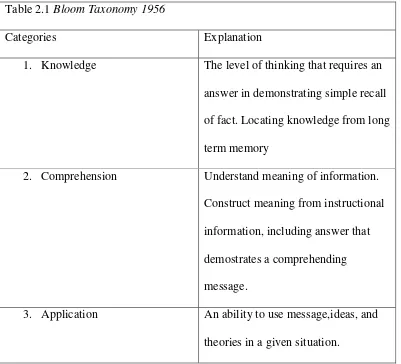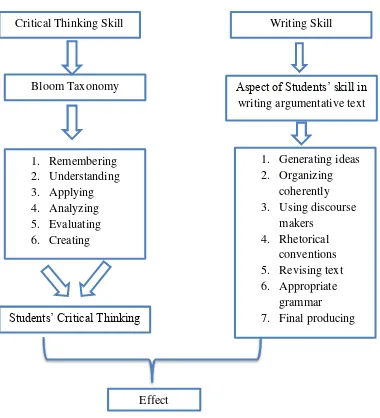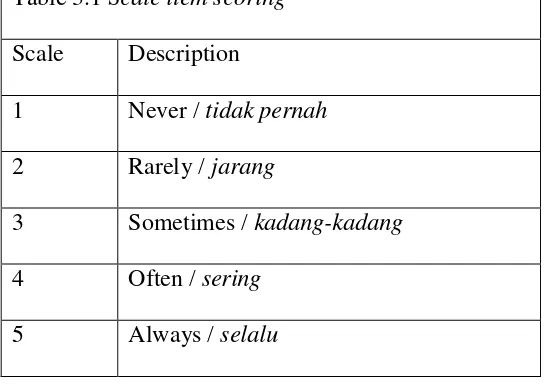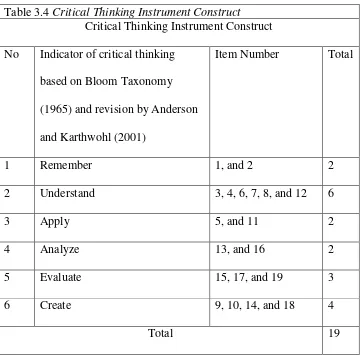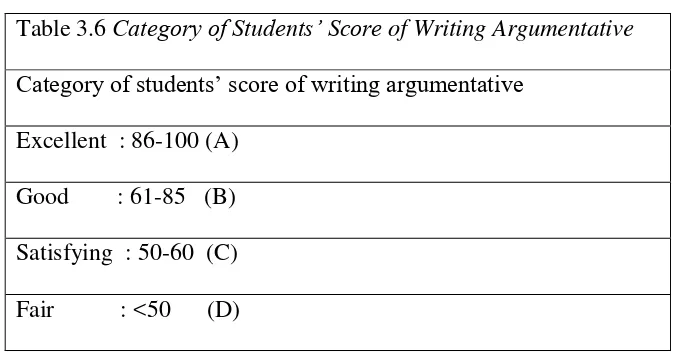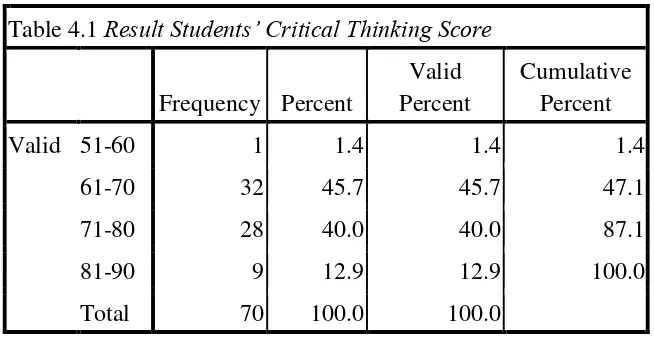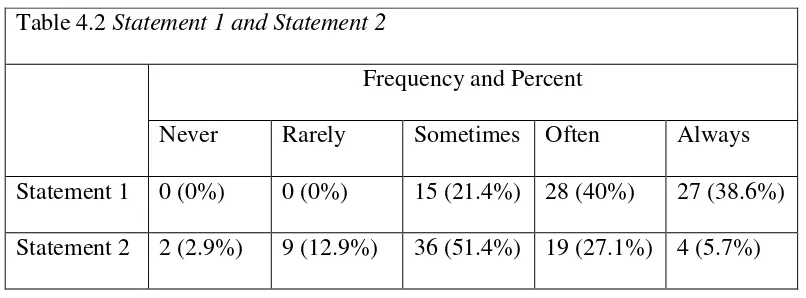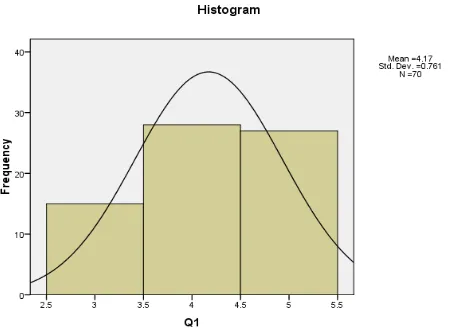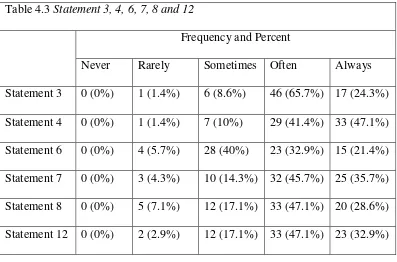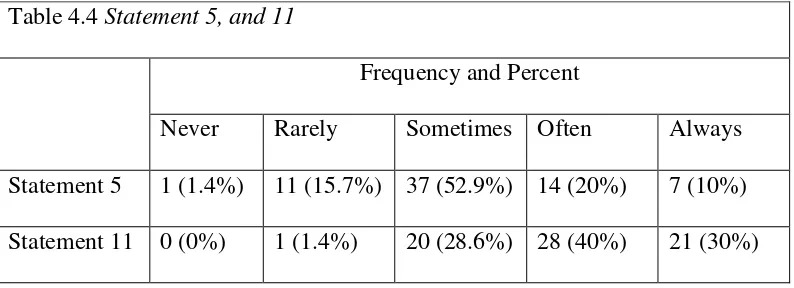i A Skripsi
Submitted to Faculty of Language Education as a Partial Fulfillment of the Requirements
for the Degree of Sarjana Pendidikan
By:
Annisa Fi’izzatillah 20120540096
English Education Department Faculty of Language Education Universitas Muhammadiyah Yogyakarta
i
The Effect of Students’ Critical Thinking toward Students’ Skill in Writing Argumentative Texts at English Education Department of Universitas
Muhammadiyah Yogyakarata
A Skripsi
Submitted to Faculty of Language Education as a Partial Fulfillment of the
Requirements
for the Degree of Sarjana Pendidikan
By:
Annisa Fi’izzatillah 20120540096
English Education Department Faculty of Language Education Universitas Muhammadiyah Yogyakarta
ii
Universitas Muhammadiyah Yogyakarata
We hereby approve the Skripsi of Annisa Fi’izzatillah
20120540096
Candidate for the degree of Sarjana Pendidikan
December, 28th 2016 Evi Puspitasari, S.Pd., M.Hum. The Skripsi Supervisor
December, 28th 2016 Mariska Intan Sari, S.S, MA. The Examiner I
December, 28th 2016 Ika Wahyuni Lestari, S.Pd.,M. Hum The Examiner II
Accepted Yogyakarta, December, 28th 2016
Gendroyono, S.Pd.,M.Pd
iii Name : Annisa Fi’izzatillah
NIM : 20120540096
Program Study : English Education Department
Faculty : Faculty of Language Education
University : Universitas Muhammadiyah Yogyakarta
I certify that skripsiwith the title ‘The Effect of Students’ Critical Thinking Toward Students’ Skill in Writing Argumentative Texts at English
Education Department of Universitas Muhammadiyah Yogyakarta’ is the original
my own work. I am completely responsible for the content of this paper. Others
opinions and findings included in this mini thesis are quoted in accordance with
ethical standards.
Yogyakarta, 9 December 2016
Annisa Fi’izzatillah
iv
mercy and blessing, strength and love in accomplishing my skripsi writing.
I wish to express my deepest and special gratitude to my beloved parents,
Abi, Ummi, who are always advising, supporting and loving me in my study and
my life. I dedicate this skripsi to you. I greatly indebted to my beloved sisters, I Z
Husna and Azizah QA and my beloved brothers, M I Allam S and N Faza who are
always loving and supporting me. Your old sister has finished skripsi, now.
Special gratitude belongs to my supervisor, Ms. Evi Puspitasari, M. Hum
for supporting, guiding and helping me in finishing this skripsi writing. I also
thank to my examiners, Ms. Mariska Intan Sari, MA., and Ms Ika Wahyuni, M.
Hum for all suggestions and valuable comments to improve my skripsi writing. I
also place my thanks to all the lecturers of English Education Department of
Universitas Muhammadiyah Yogyakarta, for teaching and guiding me during my
study in this department.
I also thank to my respondents, students of EED of 2015. Thank you for
providing valuable information and the time. I am also grateful for all my friends
at EED UMY 2012, especially, member of Calestials who support and help me,
Maril, Nia, Amel, Yuli, Mba Icha, Diba, Inka, Fitri, Dani, Ama, Harni and all my
beloved friends who cannot be mentioned one by one. Thanks for the friendship
v
Sincerely, I also place big thank to my beloved friends in EDSA and
Senyum Kita for the beliefs given to me when we work together in this amazing
team. I am also grateful for my friends in Liqo group and Mawar geng for
friendship and togetherness.
I also thank for all who directly and indirectly have helped me to finish
this skripsi. May Allah will provide the best things for you all. I am very grateful
to have you all. Thank you.
Yogyakarta, 16 December 2016
Annisa Fi’izzatillah
vi
Statement of Authenticity……… iii
Acknowledgment………. iv
Table of Content……….. vi
List of Table………. ix
List of Figure ……….. x
List of Appendices……… xi
Abstract………... xii
Chapter One……… 1
Introduction………. 1
Background of Study……….. 1
Identification of Problem……… 3
Limitation of Problem……… 5
Research Question……… 5
Purpose of Study……… 6
Significance of study………... 6
Chapter Two……… 8
Literature Review………. 8
Critical Thinking Skill………..………... 8
Definition of Critical Thinking Skill………... 8
Critical Thinking Process……… 9
Critical Thinking Level………. 10
vii
Writing……… 14
Definition of Writing………... 14
Aspect of Assessing Writing……… 15
Argumentative Writing……… 17
Critical Thinking in Argumentative……… 17
Related Studies……… 18
Conceptual Framework……… 21
Hypothesis………... 23
Chapter Three……….. 24
Methodology………... 24
Research Design……… 24
Research Setting and Participant………. 24
Research Instrument……….. 26
Validity of the Instrument……… 27
Reliability of the Instrument……… 28
Data Collection Method……….. 30
Data Analysis………. 30
Chapter Four……… 33
Findings and Discussion……… 33
Findings………... 33
The Students’ Critical Thinking of English Education Department UMY Batch 2015……… 33
viii
Discussion……… 49
The Students’ Critical Thinking of English Education Department UMY Batch 2015……… 49
The Students’ Skill in Writing Argumentative Text of English Education Department UMY Batch 2015……… 50
The Effect of EED UMY Batch 2015 Students’ Critical Thinking on Improving Writing Argumentative Text in Interpretive Reading and Argumentative Writing……….. 51
Chapter Five……… 53
Conclusion and Recommendation………. 53
Conclusion………. 53
Recommendation………... 54
References………... 56
ix
List of Table
Table 2.1 Bloom taxonomy 1956………... 10
Table 3.1 Scale item scoring……… 27
Table 3.2 The criteria of reliability……….. 29
Table 3.4 Critical thinking instrument construct………... 29
Table 3.5 Category of students’ critical thinking skill based on interval formula…... 31
Table 3.6 Category of students’ score of writing argumentative…………... 31
Table 4.1 Result students’ critical thinking score………... 34
Table 4.2 Statement 1 and statement 2………. 35
Table 4.3 Statement 3, 4, 6, 7, 8 and 12………... 37
Table 4.4 Statement 5 and 11………... 40
Table 4.5 Statement 13 and 16………. 41
Table 4.6 Statement 15, 17 and 19………... 43
Table 4.7 Statement 9, 10, 14, and 18………... 44
Table 4.8 Students’ score of writing argumentative text………. 46
Table 4.9 Result effect of critical thinking toward writing argumentative………….. 48
x
writing argumentative text………... 22
Figure 4.1 Histogram critical thinking scale ………... 34
Figure 4.2 Histogram statement 1………..……….. 36
xi
List of Appendices Appendix 1. Questionnaire of
critical thinking scale ………. 60
Appendix 2. Number item expert judgment
………. 64
Appendix 3. Number item validity
………. 67
Appendix 4. Reliability of critical thinking scale before research
………. 71
Appendix 5. Reliability of critical thinking scale after research
………. 71
Appendix 7. The effect of students critical thinking toward students’ skill in writing argumentative text
………. 72
Appendix 8. The data of students’ critical thinking scale and students score in writing argumentative text
xii Abstract
This study aims to find out students’ critical thinking skill, students’ skill in
writing argumentative text, and effect of students’ critical thinking on improving
skill in writing argumentative text in Interpretive Reading and Argumentative
Writing course. Data were collected from seventy-five students batch 2015,
selected from the second year of EED UMY undergraduate students. The
researcher used the adapted questionnaire from Mincemoyer and Perkins (2005)
to measure critical thinking level. Furthermore, the students’ score of
argumentative writing data were taken from writing argumentative score. The data
were analyzed using descriptive statistic and simple regression in SPSS 16.
Simple regression was used to see the effect of critical thinking toward students’
argumentative writing skill. The findings showed that students’ critical thinking
skill was in the high level (70-80) and students’ score in writing argumentative
text was in the good level (61-85). The finding also showed that number of sig.
was 0.869 > 0.05 meaning there was no significant effect of students’ critical
thinking skill toward students’ skill in writing argumentative text. Critical
thinking ability has no significant effect to students score in writing argumentative
text.
Chapter One Introduction
This chapter presents several points to reveal an accurate discussion of the
main problem of the research. This chapter elaborates the background of the
study, statement of the problem, limitation of the problem, research question, and
purpose of the study. The significance of the study is also presented in this
chapter.
Background of Study
Writing is one of important skills for communication. In a business field
for example, when people want to apply for a job, they need to write a curriculum
vitae and an application letter to persuade the manager of the company where they
want to propose. In addition, in an academic field, writing a thesis is one of the
obligations to graduate from the university. It means that writing skill plays a role
in communication. Hence, students have to master writing skills to support their
academic performance.
Based on the researcher’s experience as a student, writing is the most
complex and difficult skill in English language learning for students. It is because
students need a long process to create their product of writing. Students should
pay attention in creating idea, using grammar, arranging sentence structure, using
vocabulary in a right context, and organizing paragraphs. In this case, writing
organization, the error in writing should be minimized, and the writing must be
understandable to the reader.
At English Education Department (EED) of Universitas Muhammadiyah
Yogyakarta (UMY), students take Interpretive Reading and Argumentative
Writing class as a compulsory subject in semester two. Interpretive Reading and
Argumentative Writing is an important subject in EED UMY to improve students’
ability in writing argumentative text, and mini research papers. In that class, to
encourage students in writing, the teacher designs various activities for them. One
of the activities is to write an argumentative article. In this activity, students have
to be a critical reader and they have to interpret texts. After the students read and
interpret the text, the lecturer asked them to write an argumentative article.
In writing argumentative articles, students need to be critical in expressing
ideas. They also have to organize sentences to be good and structured. Students
are also demanded to choose appropriate words to express their ideas to make
information understandable. Writing argumentative text is conducted to enhance
students’ ability in argumentative writing.
Based on the researcher’s experience, several students sometimes cannot
develop their idea in writing to produce text. The skills that is included in writing
were linguistic and analytical. In this case, several students’ found difficulties on
analytical skills. The researcher found it in one of students writing task, for
instance such as on the story. The italic words are not a sentence, but is a phrase. However, students use the phrase as a sentence. This case is one of analytical
continue the phrase. This problem also happened to students in sixth semester
who had passed Intrepretative Reading and Argumentative Writing in their second
semester. It indicates that students cannot develop the idea of a phrase to be a
correct sentence.
Several students at EED UMY still do plagiarism. Based on researcher’s
experience, the lecturer found several students were submitting an entire
document written by another author as students’ task. This case will be decreased
when the students are able to think critically and are able to express their
argument logically and comprehensively based on their own perspective. In
writing argumentative texts, students need to develop their perspective about the
content of writing. When students are lack of critical thinking skill, they are not
able to develop their perspective to convince their argument. Hence, students who
do plagiarism to fulfill their task are not quite critical to analyze problems found
as an idea in writing.
Based on the above background, the researcher is interested in
investigating the effect of student’s critical thinking toward students’ writing skill
in writing argumentative texts.
Identification of Problem
Interpretive Reading and Argumentative Writing Class focuses on
students’ ability to present logical reasons and strong convincing arguments as
well as critical analysis. Judgment in the form of argumentative essays and mini
2015 via What’s App, the researcher found several problems that emerged in Interpretive Reading and Argumentative Writing Class. The problems are
students’ lacked of understand in writing. It is because students do not understand
the issue or topic that will be discussed in argumentative writing, and students are
lack of critical thinking.
First, the problem of Interpretive Reading and Argumentative Writing
Class is students’ inadequate knowledge of writing. There are several things
needed to produce writing effectively. Those are organization of ideas,
grammatical pattern, and sentence structure in writing. In fact, there are some
students at EED UMY who lacked of awareness of those conditions as they were
writing. In this case, they only focus on topic that will be discussed in their text.
Second, some students do not understand the issue or topic that will be
discussed in the argumentative writing. This case was found in several students
that do not read a lot of the material or subject. Without reading a lot, the students
cannot produce good writing. It is because in argumentative writing, students need
to read and interpret the text.
Third, some students are lack of critical thinking skill. There are two
points for creating critical thinking. Based on Duron, Limbach, and Waugh
(2006), critical thinking is the ability to analyze and evaluate information.
However, many students in second semester are still lack of critical thinking in
writing ability. Based on interview with one of student, the student have
inadequate knowledge of the subject matter of their writing. The student still
write an argumentative text. It is because the student cannot criticize, analyze, and
evaluate an article. It is probably become a cause of students to be stuck in their
ideas in writing argumentative texts.
Limitation of Problem
This research is limited on students’ critical thinking skill related to
students’ skill in writing an argumentative text. The researcher chose this topic
because based on the problems above, one of the students’ problem in writing
argumentative texts is critical thinking. The students need to think critically before
they write an article. Without critical thinking, the students could not give strong
evidence in argumentative texts.
To make this research more specific, the researcher focused on writing
texts in Interpretive Reading and Argumentative Writing Class. The researcher
also limits this research to investigate the effect of critical thinking toward
students’ skill in writing argumentative text. It discussed the significant effects of
critical thinking skill on improving students’ skill in writing argumentative texts.
Research Question
This research is intended to investigate the effect of students’ critical
thinking toward students’ skill in writing argumentative texts. Thus, there are
three main questions that are addressed in this research. The research questions of
this study are:
1. How is the EED UMY Batch 2015 students’ critical thinking skill?
2. How is the EED UMY Batch 2015 students’ skill in writing
3. How does critical thinking skill affecting EED UMY Batch 2015
students’ skill on improving writing argumentative text in Interpretive
Reading and Argumentative Writing course?
Purpose of Study
The purpose of this study are:
1. To find out the EED UMY Batch 2015 students’ critical thinking skill.
2. To find out the EED UMY Batch 2015 students’ skill in writing
argumentative text
3. To find out the effect of EED UMY Batch 2015 students’ critical thinking
on improving students’ skill in writing argumentative text in Interpretive
Reading and Argumentative Writing course.
Significance of Study
The researcher hopes that this research can give some benefits for several
parties including the researcher, students, teachers, and other researchers.
The researcher. The researcher knows the effect of critical thinking toward students’ skill in writing argumentative texts. Additionally, the finding of
the research will be expected to help the researcher in the future to prepare
strategies to improve students’ critical thinking skill and writing skill. So, it can
help the researcher in accelerating achievement to think critically.
The students. The result of this research will give the students
information and reflection in terms of their effect critical thinking toward their
writing skill. This finding is also expected that students can increase critical
The teachers. This research provides valuable information about the effect of critical thinking toward students’ writing skill in argumentative texts. It
may encourage teachers to prepare teaching strategies in improving students’
writing skill in writing argumentative texts.
Other researchers. The researcher expects the information in this
research can be a reference for other researchers in the future who want to conduct
related study. This research provides a literature and discourse related to critical
Chapter two Literature Review
As stated in the previous chapter, the aim of this research is to investigate
whether students’ critical thinking affects students’ skill in writing argumentative
text. Therefore, the discussion in this chapter focuses on experts’ opinion related
to the literatures of critical thinking skill, concept of writing skill, argumentative
writing, and related studies will be highlighted in this chapter. The theoretical
framework of the study is also explained in this chapter.
Critical Thinking Skill
There are four topics that will be discussed in critical thinking skill. Those
are definiton of crtical thinking skill, critical thinking process, critical thinking
level, and significances of critical thinking.
Definition of Critical Thinking Skill. Many different perspectives about critical thinking has been mentioned by various educators. According to Taghva,
Rezai, Gadheri, and Taghva (2014), one of the most important methods of
creativity seeking among students is critical thinking. From this statement, it can
be considered that critical thinking is an activity to students for producing
something based on their perspective.Meanwhile, Elder and Paul as cited in
Shirkhani and Fahim (2011) stated that critical thinking refers to the ability of
individuals to take charge of their own thinking and develop appropriate criteria
and standards for analyzing their own thinking. It means that critical thinking can
Similarly, Nuget and Vitale as cited in Fahim and Pazeshki (2012) stated that
critical thinking involves purposeful, goal directed thinking in a process of
making decisions based on evidence rather than guessing in scientific problem
solving process. Thus, critical thinking ability is one of way to take choice that
person makes about something after thinking about several possibilities.
On the other hand, critical thinking requires the used imagination for
seeing things from perspectives other than our own and envisioning the likely
consequences of our positions. It is in line with Barnet and Bedau (2011) who
stated that thinking critically involves two activities. Those are analysis and
evaluation. This statement is also supported by Akyȕz and Samsa (2009), by
saying that one of the aspects of critical thinking is the ability to analyze,
understand, and evaluate an argument.
To sum up, based on definition and explanation above, critical thinking
skill is regarded as an art or ability to contemplate mind for criticizing, analyzing,
and evaluating an issue or subject in positive side and negative side. It is a way to
build creative thinking from investigating ideas to making judgment into own
perspective. Critical thinking also becomes a basic thing in creativity seeking.
Critical Thinking Process. There are six core processes of critical thinking. Based on Facionce (2011), core of critical thinking consists of
interpretation, analysis, evaluation, inference, explanation, and self-regulation. It
is in line with Ruggiero (2004) who stated that there are some activities of
thinking. They are investigation, interpretation, and judgment. On the other hand,
effective thinking and problem solving. Those are identifying the problem,
defining the context, enumerating the choices, analyzing option, listing reason
explicitly, and self-correcting. This problem solving step guides the students
through the critical thinking process and utilized learner collaboration.
Critical Thinking Level. Critical thinking involves six levels in thinking. According to Bloom Taxonomy as cited in Duron, Limbarch, and Waugh (2006),
higher order of thinking consists of six levels. Those are knowledge,
comprehension, application, analysis, synthesis, and evaluation.
The following table explain more about Bloom Taxonomy (1956)
Table 2.1 Bloom Taxonomy 1956
Categories Explanation
1. Knowledge The level of thinking that requires an
answer in demonstrating simple recall
of fact. Locating knowledge from long
term memory
2. Comprehension Understand meaning of information.
Construct meaning from instructional
information, including answer that
demostrates a comprehending
message.
3. Application An ability to use message,ideas, and
4. Analysis A skill to see way of achieving things
and classify information, ideas, and
theories into component parts.
5. Synthesis An ability to create or decide original
product.
6. Evaluation An ability to evaluate or make a
judgment based on sensible reason.
In addition, critical thinking based on Bloom Taxonomy 1956 revised by
Anderson and Krathwohl (2001) as cognitive domain of critical thinking. The
differences between Bloom Taxonomy(1965) and revision by Anderson and
Krathwohl (2001) are based on model namely on the form of level name (noun to
verb). Anderson and Krathwohl (2001) state that cognitive process dimension
consists of remembering, understanding, applying, analyzing, evaluating, and
creating.
Remember. The original verb from Bloom Taxonomy (1956) is
knowledge, but it was renamed as remember. In this step, there are two processes,
recognizing and recalling. Recognizing is a way to know someone or something
because you have seen, heard, or experienced them before. After recognizing, the
next process of this step is recalling. It is a way to bring the memory of a past
event into your mind, and often to give a description of what you remember.
subcategories in understand. Interpreting, exemplifying, classifying, summarizing,
inferring, comparing, and explaining are subcategories in understand. Interpreting
is a way to decide what the intended meaning of something is. Exemplifying is a
way to be or give a typical example of something. Classifying is a way to divide
things or information into groups according to their type. Summarizing is a way to
express the most important facts or ideas about something or someone in a short
and clear form. Inferring is a way to form an opinion or guess that something is
true because of the information that you have. Comparing is a way to examine or
look for the difference between two or more things. Explaining is when you have
to explain or give a good reason for your actions. In addition, the highest
subcategories in understand is able to explain. It means, the learner really
understands when they can explain something.
Apply. It is about carrying out or using a procedure in a given situation. There are two main subcategories in apply, that is executing and implementing.
Executing is a way to do or perform something, especially in a planned way. After
executing, the next subcategories is implementing to put a plan or system into
operation.
Analyze. It is about examining something in detail, in order to discover more about an issue. Analyze is divided into three subcategories. There are
differentiating, organizing, and attributing. Differentiating is a way to show or to
find the difference between things which are compared. After differentiating, the
elements or function within a structure. The highest subcategories in analyze is
attributing. It is a way to think something has particular quality or feature.
Evaluate. It is about making judgment based on criteria and standards. The criteria and standard can be measured by checking and critizing. Checking is
to make certain that something or someone is correct, safe or suitable by
examining it or them quickly. Critizing is a report of something such as a political
situation or system, or a person’s works or ideas, which examine an often negative
judgment.
Create. It is a way to put elements together to form a coherent or functional whole. In high order of thinking, create by considering generating to
cause something exist, plan by act or decide how to do something, and producing
to make something or to bring something into existence.
These two kinds of Bloom taxonomy only have little difference on model
namely from noun to verb. However, this study will use revised Bloom Taxonomy
as basic theory in developing this research.
Significances of Critical Thinking. Critical thinking is a framework for any discipline. Based on Bassham, Irwin, Nardone, and Wallace (2011), Critical
thinking is valuable in many contexts outside the classroom and the workplace. It
is in line with Hatcher and Spencer as cited in Duron et al. (2006) who stated that
critical thinking is needed in the workplace as an essential and important skill. It
can support people to deal with mental and spiritual problem, and it can be used to
evaluate people, policies, and institutions, thereby avoiding social problems. It
addition, skill in critical thinking will help people to be more exact and accurate in
nothing what is relevant and what is not (Cotrell, 2011). It means that with critical
thinking, people will be spesific and accurate in deciding something.
In education field, language learners who have improved critical thinking
skills are able to do activities of which other students may not be able (Shirkhani
& Fahim, 2011). In addition, Mahyudin, Lope, Elias, and Konting (2004) as cited
in Shirkhani and Fahim (2011) stated that the language learner with critical
thinking skill are capable of thinking critically and creatively to accomplish
purposes of the courses. Accordingly, this is essential for educational field to help
the learner become a critical thinker by applying it as the purpose of learning.
In English for Foreign Language (EFL), students need critical thinking to
improve their language proficiency. Fahim and Sa’eepour (2011) argued that
teaching critical thinking skills in EFL context can improve language learning. It
is by containing critical thinking skills in language classroom. In addition, Liaw
(2007) argued that the English language learners need to practice critical thinking
in all domains. To sum up, based on argument of researchers above, the EFL
teachers have a responsibility to gain student’s critical thinking with practice in
each course to improve language proficiency.
Writing
Writing is one of four major language skills. There are two topics that will
be discussed at this section. Those are definition of writing, and aspect of assesing
Definition of Writing. Writing is one of productive skills from four basic skills in English proficiency. Writing is a complex activity involving many skills
to determine ideas and to transfer the ideas onto a piece of paper clearly and
comprehensibly for the readers (Brown, 2007). It means that writing is one of
language skill that needs extra effort for learner because the learner should master
many varieties of writing as well as engaged into complex learning process.
According to Brown (2007), writing is a complex process which involves a result
of thinking, drafting, and revising procedures. By this definition, writing includes
complex skill in English, because it is a productive skill and involves higher order
of thinking in writing process. According to Turk and Kirkman (2005), writing
must transfer ideas and information to other people. It means that writing plays a
role as communication tool to transfer ideas into accurate information.
Aspect of Assessing Writing. Assessing students’ writing need evaluation checklist to measure students’ ability in writing. The evaluation checklist can
indicate to students their areas of strength and weakness. According to Brown
(2007), there are six general categories are often basic for evaluation students
writing. They consist of content, organization, discourse, syntax, vocabulary, and
mechanics.
Content. the content related to the ideas are contained in a piece of writing. It also include thesis statement, development of ideas through personal
experience, illustration, facts, opinions, and consistent focus. The scale score of
Organization. Organization in writing is an activty to arrange the effective writing. It is also included of effective of introduction, logical sequence of ideas,
conclusion, and appropriate length of text. The scale score of organization for
writing assesment are 0-20 point.
Discourse. Discourse is a piece of writing about topic sentences,
paragraph unity, transitions, discourse makers, cohesion, rhetorical conventions,
reference, fluency, and variation. The scale score of discourse for writing
assesment are 0-20 point.
Syntax. Syntax is about grammatical term. The grammatical arrangement of words in a sentence. The scale score of syntax for writing assesment are 0-12
point.
Vocabulary. Vocabulary is all the words which exist in a partcular language or subject. In writing, students hove to pay attention in vocabulary
choise for appropriate sentences. The scale score of vocabulary for writing
assesment are 0-12 point.
Mechanics. Mechanic of writing included spelling, punctuation, citation of references, neatness, and appearance. The scale score of machanics for wrting
assesment are 0-12 point.
Based on six aspects of assesing writing above, the researcher conclude
that evaluation of student writing can be measured through various aspects and
rating scales. The total high score for all of evaluation is 100 point. Hence, the
evaluation checklist will help the teacher to assess the students’ writing as fairness
Argumentative Writing.
Argumentative writing is one genre of writing. Giving argument to prove
the fact or information in written form is a goal of argumentative writing. It is in
line with Hillocks (2011) who states that the aim of creating an argument is to
assure an audience or reader of the rightness of the claims being made using
logical reasoning and relevant fact. It means that the writer gives evidence to
assure the reader to achieve the goal of writing. In addition, argumentative writing
is a kind of critical thinking and rhetorical production involving a claim,
supportive evidence, and assessment of the warrants (Newel, Vanderheide, Olsen,
& Team, 2013). Accordingly, argumentative writing plays significant role as a
way to think critically and prove the reader with rationally truth.
There are five basic conceptions in argumentative writing. It is in line with
Toulmins as cited in hillocks (2010) who stated that Toulmins’ basic conception
of argumentative writing consists of several elements. There are claims based on
evidence, with warrant that explain how evidence prove the claim, backing prove
the warrant, qualifications, and rebuttals that refute contending claims. Hence,
argumentative writing needs evidence to support the argument that you write on
it. Argumentative writing conception demands learner to activate their thinking
skill. It will support the evidence by determining material qualifications that asure
the reader should be included in their writing.
Based on the definition of writing above, writing is closely related to
critical thinking skill. According to Deane, Odendahl, Quinlan, Fowles, Welsh,
and Tatum (2008), students should be able to use writing as a vehicle for critical
thinking. Accordingly, a teacher should assess students’ writing to integrate
critical thinking in writing. It is in line with Horger (2013) who stated that to
produce good writing, students have to be able to generate more cohesive and
coherent argument about literature. It means that, critical thinking will give
impact of process of honing an argument over the writing product.
Furthermore, thinking, organizing, re-thinking, and re-organizing are a
continuous process of writing. Based on Cottrel (2011), writing skill need critical
thinking. Those are involve process of providing reason, using evidence,
comparing and evaluating arguments, weighing up conflicting evidence, and
forming judgments on the basic evidence. It means that in a writing process the
students are required to use critical thinking.
According to these experts’ opinion, critical thinking and writing have
strong relationship. When students have a good critical thinking skill, they will be
easier in creating ideas and evidences for producing writing. They will have to
know how to decide idea, analyze, make argument with evidence, and apply other
critical thinking aspect that help them in writing process.
Related Studies
The following are the previous studies related to the variable of the present
study composing critical thinking skill and student skill in writing argumentative
Reading Comprehension of Iranian EFL Learners was conducted by Fahim and Sa’eepour (2011). The study was conducted to investigate the impact of teaching
critical thinking skill on reading comprehension ability by applying debate on
EFL learners. It was carried out in English Institute in Karaj Iran. The total of
participants were 60 intermediate students. The instrument is used Nelson test.
The reading comprehension and a critical thinking appraisal post test were
administered to the two groups. During the term, experimental group received 8
sessions of treatment using debate. To compare the two group they were given the
same test as post test. The result showed significant difference between two
groups on reading comprehension test, but the difference on critical thinking test
was non-significant.
The next study entitled Content-Based Reading and Writing for Critical Thinking Skills in an EFL Context was conducted by Liaw (2007). It was carried out to find out the effectiveness of promoting learners’ critical thinking skills and
EFL skills with a content-based approach. It was conducted in junior high school
in central Taiwan. There were 32 students, whose ages are 12 to 13 years old as
the participant of the study. The method used in the study was experimental study.
The participants of the study were divided into two groups, one being
experimental and one being controlled. Data were collected from class
assigments, a critical thinking assesment instrument, questionnaire, and a
teacher-constructed language profeciency test. The result showed revealed significant
gains in the students’ English language proficiency test score. Critical thinking
positive responses toward the content based EFL learning and teaching from the
participating students. Based on the result, instructional suggestions and caveats
are provided.
In addition, Learning to Improve: Using Writing to Increase Critical Thinking Performance in General Education Biology was the next related study conducted by Quitadamo and Kurtz (2007). It was carried out at a state-funded
regional comprehensive university in the pasific Northwest. The participants was
non major undergraduates who was taking biology in their general education
science requirement. The participants of the study were divided into two groups,
one being experimental and one being controlled. An experimental group
consisted of 158 participants and controlled group consisted of 152 participants.
Data were collected by pre test and post test critical thinking assesment. The result
showed the writing group (experimental) significantly improved in critical
thinking skill whereas the non writing group (control) were not signify. Analysis
and inference skills increased significantly in writing group but not the non
writing group. Writing students also showed greater gains in evaluation skills,
however these were not significant.
The previous studies above show the similarity with this research. The
previous studies use quantitative approach for examining the relationship among
variables. However, Sa’eepour (2011), Liaw (2007), and Quitadamo and Kurtz
(2007) investigated the same variable of critical thinking and writing skills, they
applied different design from this research. Their studies are categorized as an
critical thinking toward writing skill. this research can be considered that this
research is not replica from the previous studies, instead it is an expansion as well
as more specific research focusing on critical thinking and students’ skill in
writing argumentative texts as the variables of this research.
Conceptual Framework
This research focused on investigating the effect of students critical thinking
toward students skill in writing argumentative texts at EED UMY Batch 2015.
The researcher applied Bloom Taxonomy as the foundation of this research.
Cottrell (2011) mentioned that there are three factors that influence students’
critical thinking, such as knowledge, skills, and attitude. Bloom Taxonomy (1956)
revised revision of Bloom taxonomy by Anderson and Krathwohl (2011) require
the higer oder of thinking that caracterizes critical tough. He arranged the
hierarchical structure of cogntive process dimension consist of remembering,
understanding, applying, analyzing, evaluating, and creating. Additionally,
according to Brown (2007) the product of compositional nature of writing has
produced writing pedagogy that focuses how generate ideas, organize coherently,
use discourse makers and rhetorcal conventions to put them cohesively into
written text, revise text for clearer meaning, edit text for approriate grammar, and
product final product. Following figure 2.1 describes the estimated effect of
Figure 2.1 Conceptual framework of critical thinking skill and students skill in writing argumentative texts.
Figure 2.1 reveals that the effect of critical thinking skill toward students’
skill in writing argumentative texts may be directly propotional. It means that if
the students have a good critical thinking, they are able to be good at writing Aspect of Students’ skill in writing argumentative text Students’ Critical Thinking
1. Remembering
argumentative texts. On the contrary, if students lack of critical thinking, they are
poor in writing argumentative texts.
Hypothesis
This research proposes some hypothesis as follows:
1. Null hypothesis (H0), there is no significant effect of English Education
Department of Universitas Muhammadiyah Yogyakarta batch 2015
students’ critical thinking skill toward students’ skill in writing
argumentative texts in Interpretive reading and Argumentative Writing
Class in second semester.
2. Alternative hypothesis (Ha), there is a significant effect of English
Education Department of Universitas Muhammadiyah Yogyakarta batch
2015 students’ critical thinking skill towardstudents’ skill in writing
argumentative in Interpretive reading and Argumentative Writing Class
Chapter Three
Methodology
This chapter presents research design, setting, participant of the research,
research instrument, and data collection method. Moreover, data analysis is also
presented in this chapter.
Reserch Design
This research used quantitative approach. It is because the researcher
investigate the effect of students’ critical thinking toward students’ skill in writing
argumentative texts in which the data are going to be analyzed quantitatively. This
research also has independent and dependent variable. Then this research is
suitable to use quantitative approach. According to Creswell (2014), quantitative
research is an approach for testing objective theories by examining the
relationship among variables. In addition, this research used ex post facto
(causal-comperative) design as the method. Based on Kothari (2004), ex post facto design
is one of non-experimental quantitative research types in which the researcher has
no control over the variables.
Research Setting and Participants
The setting of this research was in EED UMY. There are some reasons of
choosing EED as the setting. First, the problem of Interpretive Reading and
Argumentative Writing Class is students’ inadequate knowledge of writing.
Second, the phenomenon in EED related to students’ critical thinking ability in
critically to prove the evidence in writing argumentative texts. The other reason is
to measure EED students’ critical thinking. Moreover, the researcher is also
studying at EED UMY. It is easier to gather the data. The researcher conducted
the research in November 2016.
The participants of this research are the students of EED UMY Batch 2015
who take Interpretative Reading and Argumentative Writing Class. It becomes
consideration because in Interpretative Reading and Argumentative Writing Class,
the students need critical thinking for express their argument. The other reason is
that the students batch 2015 have just finished the Interpretive Reading and
Argumentative Writing Class. It ease the researcher to gather the data because
batch 2015 are still take some courses.
This research used convenience sampling. Convenience sampling take total of
participants in the sample based on the ease of access (Kothari, 2004). The
researcher used convenience sampling to conduct this research. The participants
joined this research because of their availability and willingness. It is in line with
Creswell (2014) who state that the participants of convenience sampling are
chosen based on their convenience and availability. The researcher chose the
respondents who were accessible and available at that time.
The total of research population is 140 students. The population is all
items in any field of inquiry a universe (Kothari, 2004). To know the sample size,
the researcher used Slovin Formula. The percentage of the accuracy level is 10%.
The reason researcher used accuracy level of 10% is because the total population
Slovin Formula (Kriyantono, 2008):
n =
�1+� �2
n : sample size
N: population
e : precision level (0,1)
Based on Slovin Formula computation, the sample size for this research
minimum has 58 students for being participants. For the result, there were seventy
students of batch 2015 from three classes (A-C) who become samples of this
research based on their attendance at that time.
Research Instrument
In this quantitative research, the researcher used questionnaire to collect
the data of students’ critical thinking skill. This research used closed ended
questionaire because the researcher provides the alternative answers. Closed
ended questionnaire have the advantages of easy handling, simple to answer,
quick and relatively inexpensive to analyze (Kothari, 2004). The researcher used
likert scale in the questionaire. According to Kothari (2004), likert scales consist
of numbers of statement which express either a favourable or unfavourable
attitude towards the given object to which the participant is asked to react. In this
scale, participants state what they like and dislike. The researcher decides to use
1-5 scale. They are never, rarely, sometimes, often, and always. The score of
Table 3.1 Scale item scoring
Scale Description
1 Never / tidak pernah 2 Rarely / jarang
3 Sometimes / kadang-kadang 4 Often / sering
5 Always / selalu
The questionaire was created based on cognitive domain of critical
thinking based on Bloom Taxonomy (1956). This research used questionaire
adapted from Mincemoyer and Perkins (2005) to measure students’ critical
thinking skill. The questionnaire is to find out the EED UMY Batch 2015
students’ critical thinking skill. the researcher changes the language questionnaire
from English to Indonesian. It is for make clearly and understandable for the
participant.
Additionally, this research used students’ argumentative writing score
document as the instrument to know the effect of students’critical thinking toward
students’ skill in argumentative writing. The students’ score of argumentative
writing were taken from test writing argumentative at Interpretive Reading and
Writing Argumentative course.
Validity of the Instrument. Validity is indicates the degree to which an instrument measures what it is supposed to measure (Kothari, 2004). An
measure. To know the construct validity of this instrument, the researcher did
piloting the questionnaire to check wheather the instrument can be used to
measure students critical thinking or not. Based on Kothari (2004), construct
validity is the degree to which scores on a test can be accounted by the defining
construct of a sound theory. For checking construct validity, this research used
expert judgment of two lecturers of EED who master this topic. The researcher
changes eight items out of nineteen items, because to make the sentences more
understandable.
The researcher did piloting to twenty-two students of EED UMY Batch
2015 class D to know whether the instrument could be used to measure students
critical thinking or not. The piloting used questionnaire adapted from Mincemoyer
and Perkins (2005) and students’ argumentative writing score document. The
researcher used descriptive statistic in SPSS 16 to analyze piloting. Arikunto
(2002) divided criteria of validity instrument into five levels 0,81 – 1,00 (very
high) 0,61 – 0,80 (high) 0,41 – 0,60 (enough) 0,21 – 0,40 (low) 0,00 – 0,20 (very
low). Then, the nineteen items were piloted.
Reliability of the Instrument. Reliability of the scores on instruments lead to meaningful interpretation of data. In this research, the reliability performed
used Cronbach’s Alpha Formula technique in SPSS 20.0 for windows. Sekaran
Table 3.2 The Criteria of Reliability
The Criteria of Reliability (Alpha)
1. 0.8-1.0 Good
2. 0.6-0.799 Moderate
3. <0.6 Not Good
The language of questionnaire this research used Indonesian. It is to make
clearly and understandable for the participant. The table below is the
questionnaire of critical thinking instrument construct.
Table 3.4 Critical Thinking Instrument Construct
Critical Thinking Instrument Construct
No Indicator of critical thinking
based on Bloom Taxonomy
(1965) and revision by Anderson
and Karthwohl (2001)
Item Number Total
1 Remember 1, and 2 2
2 Understand 3, 4, 6, 7, 8, and 12 6
3 Apply 5, and 11 2
4 Analyze 13, and 16 2
5 Evaluate 15, 17, and 19 3
6 Create 9, 10, 14, and 18 4
Data Collection Method
This research used questionaire to collect the data of students’ critical
thinking skill. The procedures in collecting the data involve some steps. The
questionaire was distributed to seventy students of EED Batch 2015. The
researcher asked permission to the lecturer before coming to the class. Before the
students answer the questionnaire, the researcher explained how to answer the
questions and asked the participants to fill out the consent form first. The
participants answered the questionaire in the class around 15-20 minutes.
To get the data of students agrumentative writing skill, the researcher used
score document taken from the lecturer of intepretive reading and argumentative
writing class. Before that, the researcher asked permission to the lecturer of
interpretive reading and argumentative writing class in taking the students’ scores.
Data Analysis
This research has two variables, an independent variable and a dependent
variable. The independent variable of this research is students’ critical thinking
skill, and students’ skill in writing argumentative text is the dependent variable.
The researcher identifies the frequency of questionaire using descriptive statistics
Table 3.5 Category of Students’ Critical Thinking Skill
Based on Interval Formula
Category Value
Very low 15-25
Low 26-36
Lower middle 37-47
Middle 48-58
Upper middle 59-69
High 70-80
Excellent 81-90
The scores of students argumentative writing text was categorized using
interval formula to divide the categorize range to reveal students’ skill in writing
argumentative text.
Table 3.6 Category of Students’ Score of Writing Argumentative Category of students’ score of writing argumentative
Excellent : 86-100 (A)
Good : 61-85 (B)
Satisfying : 50-60 (C)
Fair : <50 (D)
Moreover, the data was processed and analyzed to reveal the significant
regression method. This method aims to find whether there is effect of students
critical thinking skill toward students’ skill in writing argumentative text.
To know the efffect of dependent variable toward independent variable,
this research used simple regression analysis by using a tool called Statistical
Package for Social Sciences (SPSS) 16 and Microsoft Excel to make easier in
analyzing the data. The formula is y = ɑ+bx. This can be translated into English
as the value of the dependent variable (y) is predicted to be a constant (a) plus a
coefficient (b) times the independent variable (x). Where the symbol y denotes the
estimated value of y for a given value of x. This equation is known as the
regression equation of y on x which means that each unit change in x produces a
change of b in y, which is positive for direct and negative for inverse
Chapter Four Findings and Discussion
This chapter presents the answer of the three research questions. The first
research question is “How is the EED UMY Batch 2015 students’ critical thinking
skill?”. the second question is “How is the EED UMY Batch 2015 students’ skill
in writing argumentative text?” and the third is “Does critical thinking skill affect
EED UMY Batch 2015 students’ skill on improving writing argumentative text in
Interpretive Reading and Argumentative Writing?”. The discussion of the findings
is also presented in this chapter.
Finding
Finding 1. The Students’ Critical Thinking of English Education Department Batch 2015
The questionnaire of critical thinking scale was distributed to seventy
students of EED UMY Batch 2015 from class A, B, and C. From the result of the
total scores of critical thinking scale, the researcher divided seven categorized
Based on this result, there are one student of seventy (1.4%) who have
critical thinking score between 51-60. There are thirty-two students (45.7%) who
have critical thinking score between 61-70. There are twenty-eight students (40%)
who have critical thinking score between 71-80, and there are nine students
(12.9%) who have critical thinking score between 81-90. The result can be seen
clearer in the histogram below
Figure 4.1 Histogram critical thinking scale Table 4.1 Result Students’ Critical Thinking Score
Frequency Percent
Valid Percent
Cumulative Percent
Valid 51-60 1 1.4 1.4 1.4
61-70 32 45.7 45.7 47.1
71-80 28 40.0 40.0 87.1
81-90 9 12.9 12.9 100.0
Based on the histogram, the result showed that mean of students critical
thinking scale were on the 71.97. From the result of interval formula 70-80
considered in high level of critical thinking. It means that most of EED students
Batch 2015 have high level of critical thinking.
Bloom Taxonomy revised by Anderson and Karthwohl (2001) divided six
cognitive domain of critical thinking, namely remembering, understanding,
applying, analyzing, evaluating, and creating, the findings show the respondents’
critical thinking scale of each indicator.
Remembering. The indicator of remember is reflected on two statements of questionnaire. They are number one and two. The respondents’ critical thinking
scale of indicator remembering were presented in the table below
Table 4.2 Statement 1 and Statement 2
Frequency and Percent
Never Rarely Sometimes Often Always
Statement 1 0 (0%) 0 (0%) 15 (21.4%) 28 (40%) 27 (38.6%)
Statement 2 2 (2.9%) 9 (12.9%) 36 (51.4%) 19 (27.1%) 4 (5.7%)
In the statement 1, there were fifteen students (21.4%) who chose
sometimes think possible result before take an action and twenty-eight students
(40%) who chose often think possible result before take an action. Then, there
were twenty-seven students who chose always think possible result before take an
most of students were often think possible result before take an action. The result
can be seen clearer in the histogram below.
Figure 4.2 Histogram statement 1
In the statement 2, there were four students (5.7%) who always got idea
from other people when having task and nine teen students (27.1%) who often got
idea from other people when having task to do. Then, there were two students
(2.9%) who never got idea from other people when having task to do. There were
nine students (12.9%) who rarely got idea from other people when having task to
do. There were thirty-six students (51.4%) who chose sometimes got idea from
other people when having a task to do. The result of mean students answer
questionnaire are 3.2. It means that most of students sometimes got idea from
other people when having a task to do.
To be highlighted, the results show that the students indicate high
cognitive domain in indicator of remembering. Most of the students were often
think possible result before take an action. It means that, the students at EED
something. It is in line with Anderson and Karthwol (2001) who said that
remember as indicator of cognitive domain represents the recognizing and
recalling memory of past event in mind.
Understanding. The indicator of understanding was reflected on six statements. They are number 3, 4, 6, 7, 8, and 12. The six statements were
presented below
Table 4.3 Statement 3, 4, 6, 7, 8 and 12
Frequency and Percent
Never Rarely Sometimes Often Always
Statement 3 0 (0%) 1 (1.4%) 6 (8.6%) 46 (65.7%) 17 (24.3%)
Statement 4 0 (0%) 1 (1.4%) 7 (10%) 29 (41.4%) 33 (47.1%)
Statement 6 0 (0%) 4 (5.7%) 28 (40%) 23 (32.9%) 15 (21.4%)
Statement 7 0 (0%) 3 (4.3%) 10 (14.3%) 32 (45.7%) 25 (35.7%)
Statement 8 0 (0%) 5 (7.1%) 12 (17.1%) 33 (47.1%) 20 (28.6%)
Statement 12 0 (0%) 2 (2.9%) 12 (17.1%) 33 (47.1%) 23 (32.9%)
In the statement 3, the table above shows that seventeen students (24.3%)
who always develop idea by gathering information and forty-six (65.7%) students
who often develop idea by gathering information. Then, six students (8.6%) who
sometimes develop idea by gathering information. In addition, only one student
In the statement 4. There were thirty-three students (47.1%) who chose
always identify options when facing problem and twenty-nine students (41.4%)
who often identify options when facing problem. Seven students (10%) stated that
sometimes identify options when facing problem and only one (1.4%) who rarely
identify options when facing problem. It means that most of students did inferring
when facing problem. The data showed that among all participant EED UMY
Batch 2015, there were 88.5% students who indicate high ability in identifying the
solutions when facing problem.
Based on data above, the statement of 6. There were fifteen students
(21.4%) who always able to give reason for opinions. There were twenty-three
(32.9%) who often able to give reason for opinions. There were twenty-eight
students (40%) who sometimes able to give reasons for opinions. It means, most
of students in EED UMY Batch 2015 were sometimes able to give the reasons for
opinion. Only four students (5.7%) were rarely to give reasons for opinions.
Based on the data above, statement 7. There were thirty-two students
(45.7%) chose often important to get information to support own opinions. There
were twenty-five students (35.7%) chose always important to get information to
support own opinions. Then, there were ten students (14.3%) chose sometimes
important to get information to support own opinions and three students (4.3%)
chose rarely important to get information to support own opinions. It means most
of students EED UMY Batch 2015 often got information for support own
Based on this data, the statement 8. There were thirty-three students
(47.1%) chose often have more than one source of information before making
decision. There are twenty students (28.6%) chose always have more than one
source of information before making decision. Then, there are twelve students
(17.1%) chose sometimes and only five students (7.1%) chose rarely have more
than one source of information before making decision. It means that, most of
students EED UMY Batch 2015 before making decision, they were comparing the
information from different source. It was supposed to prove the strong evidence of
opinion.
Based on the table above, the statement 12. There were thirty-three
students (47.1%) who often took decision based on information they got and
twenty-three students (32.9%) who always took decision based on information
they got. Then, twelve students (17.1%) who sometimes took decision based on
information they got and only two students (2.9 %) who rarely took decision
based on information they got.
To be highlighted, the result showed that the students have a good
indicator in one of cognitive domain of critical thinking which is understanding. It
was because the percentage of students able to understand was on 4. It means that
most of students chose often in statement of understand indicator. Based on that
statement, the students have good classifying and inferring information to develop
idea and support the opinions. The students also able to compare the information
explaining (Anderson & Karthwol, 2001). Most of the students of EED UMY
Batch 2015 were sometimes able to explain the reason of opinions.
Applying. The indicator of applying was reflected on two number of statements. They are 5 and 11. The two statements were explained below.
Table 4.4 Statement 5, and 11
Frequency and Percent
Never Rarely Sometimes Often Always
Statement 5 1 (1.4%) 11 (15.7%) 37 (52.9%) 14 (20%) 7 (10%)
Statement 11 0 (0%) 1 (1.4%) 20 (28.6%) 28 (40%) 21 (30%)
Based on the table above, the statement of number 5. There were
thirty-seven students (52.9%) who sometimes easily express thoughts on a problem.
There were fourteen students (20%) who often easily express thoughts on a
problem. Then, there were eleven students (15.7%) who rarely easily express
thoughts on a problem and seven students (10%) who always easily express
thoughts on a problem. There was only one student (1.4%) who never easily
express thoughts on a problem.
Based on statement 11. There were twenty-eight students (40%) who often
put ideas in order by importance. There were twenty-one students (30%) who
always put ideas in order by importance. Then, there were twenty students
(28.6%) who sometimes and one student (1.4%) who rarely put ideas in order by
In conclusion, the result showed that the students have good ability for
indicator critical thinking in apply. The average of students’ ability in apply was
on 3.6. it means that most of students were often able to apply or implement by
expressing thought on a problem. Most of the students of EED UMY Batch 2015
were able to put ideas by importance. It means that, the students could implement
and used the ideas by considering the situation. It is in line with Anderson and
Karthwol (2001) stated that using ideas by considering the situation is one of
indicator of apply in cognitive domain critical thinking.
Analyzing. The indicator of analyzing was reflected on two numbers statement. They are 13 and 16. The two statements are explained below.
Table 4.5 Statement 13 and 16
Frequency and Percent
Never Rarely Sometimes Often Always
Statement 13 0 (0%) 3 (4.3%) 16 (22.9%) 26 (37.1%) 25 (35.7%)
Statement 16 7 (10%) 10 (14.3%) 23 (32.9%) 20 (28.6%) 10 (14.3%)
Based on the statement 13. There were twenty-six students (37.1%) who
often compare idea when thinking about topic. There are twenty-five students
(35.7%) who always compare ideas when thinking about topic. Then, there are
sixteen students (22.9%) chose sometimes compare ideas when thinking about
topic and three students (4.3%) who chose rarely compare ideas when thinking
Based on the statement 16. There were twenty-three students (32.9%) who
chose sometimes developed checklist to help them think about an issue. There
were twenty students (28.6%) who often developed checklist to help them think
about an issue. Then there were ten students (14.3%) who chose always developed
checklist to help them think about an issue and ten students (14.3%) who chose
rarely developed checklist to help them think about an issue. There are seven
students (10%) who chose never developed checklist to help them think about an
issue.
In conclusion, the result showed that the students have good ability for
analyzing in critical thinking indicator. Most of the students could differentiate the
ideas when thinking about an issue or topic. The mean of statement 13 was 4.04
show high favorable in differentiate ideas when thinking about issue. In other
side, the highest percentage 32.9% of students’ ability in organizing checklist to
help think about an issue showed that EED UMY Batch 2015 unusual to used
checklist in organizing the issue. It means that student was able analyze issue or
topic. The students’ habit for using checklist for organizing the issue were not
significant for students’ EED UMY Batch 2015. The result showed that the
students able to compare between issue or topic. It supported by Anderson and
Karthwol (2001), the ability to find the difference between things which are
compared including analyze of critical thinking indicator.
Table 4.6 Statement 15, 17 and 19
Frequency and Percent
Never Rarely Sometimes Often Always
Statement 15 1 (1.4%) 2 (2.9%) 19 (27.1%) 26 (37.1%) 22 (31.4%)
Statement 17 0 (0%) 10 (14.3%) 22 (31.4%) 22 (31.4%) 16 (22.9%)
Statement 19 0 (0%) 1 (1.4%) 11 (15.7%) 34 (48.6%) 24 (34.3%)
Based on the table above, the statement 15. There were twenty-six
students (37.1%) who often aware no right or wrong answers to a questions. There
were twenty-two students (31.4%) who always aware no right or wrong answers
to a questions. There were nineteen students (27.1%) who sometimes aware no
right or wrong answers to a questions. Then, there were two students (2.9%) who
rarely aware no right or wrong answers to a questions and only one student (1.4%)
who never aware no right or wrong answers to a questions.
Based on data above, the statement of 17. There were balances between
students sometimes could easily tell what they did was right or wrong and student
often could easily tell what they did was right or wrong. Each item students who
chose sometimes and often were twenty-two students (31.4%). There were sixteen
students (22.9%) who chose always could easily to tell what they did was right or
wrong. Then, ten students (14.3%) who chose rarely could easily to tell what they
did was right or wrong.
Based on the statement 19. There were thirty-four students (48%) who
